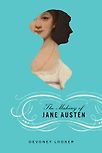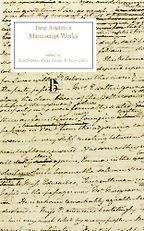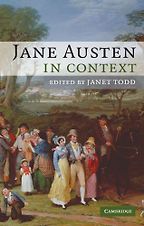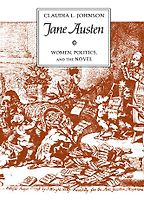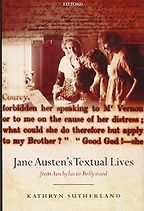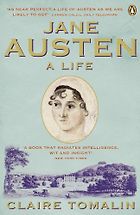Surely every Jane Austen interview needs to begin by asking: what would the literary equivalent of your final meal be? Which of the novels is the best? Actually, that might be two different questions.
I do think they are two different things. Let me take the “final meal” part. I would make the final read her final write, that is Sanditon. Reading that unfinished novel this year has been incredibly moving. It shows her going in some different, exciting directions that we have little idea how she’d have followed through with, if she’d continued writing after March 1817 [Austen died on July 18, 1817]. To me, Sanditon would be a fitting final tribute read to Austen.
It deals with illness, hypochondria, and some things that you can see must have been incredibly hard for her to mull over and write about – and make jokes about – while she herself was not well. I’m sure that’s not the answer you necessarily expected – I don’t think it’s her greatest work of art – but I find it so moving to think about that text in her bicentenary year.
Our topic is ‘Alternative Austen’ which implies, of course, that there’s a primary, conventional Austen that needs somehow to be worked against. Could you sketch what that is and how it came about?
There have long been competing Austens. So, when I’m giving you this conventional version, this isn’t as if it’s what everyone has thought. There were always people who were debating ‘What kind of a writer is she?’, ‘Who is she?’, ‘How do her writings work on us?’, ‘How should we understand her life?’, and so on.
But the overarching conventional version of Austen has been, I think, often quite staid. It’s been very polite. It’s been the tea-drinking, bonnet-wearing and safe-attractive version of Regency life that was not even Jane Austen’s reality.
This is where I think Claire Tomalin’s biography of Austen is really so important. That biography, which is now, of course, no longer new – it’s 20 years old – shifts us away from this sense of Austen having lived a life of little event. That was the conclusion many had drawn from Victorian family accounts of her, for example, that suggested there was really nothing much of interest to tell.
As you said, her image has hardly been a stable one. In Jane Austen’s Cults and Cultures (2012), Claudia L. Johnson argued that there were four critical phases of reception shaping the way we see Austen and her writing, and there’s a common view that she only really became a celebrity figure at the end of the 19th century.
I love Claudia Johnson’s Cults and Cultures. I find that book immensely inspiring, although the one I chose to recommend today is her first book. But I would take issue with part of the received wisdom that you mentioned in your question, which is that Austen’s fame didn’t get rolling until the very late 19th century. I think that story is actually overstated quite a bit. That’s one of the things that I’ve been very interested in writing about and researching: this myth that has it that before 1870 no one knew Austen, and then the nephew James Edward Austen-Leigh writes a memoir of her and she’s suddenly famous everywhere. I just don’t think that’s accurate.
“The conventional version of Austen has been often quite staid”
Regardless of where we date the start of this cult of her, though, the kinds of stories that we have told have always tended to caricature her in strange and limiting ways. Johnson’s Jane Austen’s Cults and Cultures gets at that point brilliantly.
There’s a tendency to confuse her with her characters.
Yes. There is a period in the late 19th century, too, when she was imagined as most like her heroine Elizabeth Bennet, both seen as the perfect wife. There’s a quote by George Saintsbury, who says that among literary protagonists, Elizabeth Bennet is the best one ‘to live with and to marry.’ I love that: not just to live with, not just to marry, but both! That’s a late 19th-century/early-20th-century kind of male fantasy attaching to Austen’s heroines and, for some, to Austen herself, as Elizabeth’s creator.
It’s funny that that’s going on at the same time that she’s being imagined as this safe, chaste old maid, or as a proto-feminist role model. And it’s hard to figure out how these images could be held at the same time. But obviously they were, by different people.
And what attracted you to her and her work?
My mother first tried to get me started on reading Jane Austen when I was in my early teens. I think this is a fairly common story; many girls especially discover Austen in their teens, through a family member. My mother handed me a Modern Library edition of Pride and Prejudice and Sense and Sensibility bound in the same book. I started it three times but got stuck with the language. My mother was very insistent and said ‘I really think you’re going to like this one.’ I loved to read books, but this one didn’t take immediately.
The third time I was finally able to get through what had seemed impenetrable language and see some things that were engaging and funny. I don’t think I understood the irony or the social criticism, but I got that there were some pretty amazing things going on, and the characters really grabbed me.
It was only many years later that I learned that my mother herself had never read Jane Austen. She just wanted me to be an educated person, and she knew that Austen was one of those novelists you should read, if you wanted to be educated. That has shaped my life. (I was the first in my family to get a bachelor’s degree.) Jane Austen has been with me every step of the way in a way that feels very personal to me, in terms of an intellectual journey. Again, I think that’s not uncommon. I think for a lot of people, she serves in a more familiar or family-like role, in comparison to how they imagine other books and authors in their lives.
Let’s turn to your five books and begin at the beginning – with the words of the woman herself. You have chosen Jane Austen’s Manuscript Works (2012) edited by Linda Bree, Peter Sabor and Janet Todd. What do we find here?
I didn’t recommend any of Austen’s full-length novels, because my assumption is that readers can very easily discover those on their own at this point. But if you’ve exhausted her six novels, or decided that you’ve read as much of those as you want to, then Manuscript Works is really one-stop shopping for everything else by Austen that’s interesting.
It includes just a smattering of her letters, so if you’re really looking to go into those then this isn’t the right book for you. (There you’ll either want Deirdre LeFaye’s Jane Austen’s Letters or the Selected Letters edition from Oxford University Press, edited by Vivien Jones.) But in terms of her other fiction, everything is here in Manuscript Works, from early to late.
I love the juvenilia, which is so spirited and snarky, and the later unfinished works are here, too, like Sanditon. But Lady Susan is one that if you’ve haven’t read, you really owe it yourself to do so. There’s a lot there to chew on. The film version of it that Whit Stillman brought out last year is fantastic. He retitled Lady Susan into ‘Love and Friendship’ which is a little confusing, because Austen also wrote a good juvenilia story called Love and Freindship [dated 1790], and the film is not that. It’s an adaptation of Lady Susan. If you’ve seen Kate Beckinsale in Love and Friendship then you’ll definitely want to read Lady Susan, which is what Stillman’s film was riffing on.
And what is so special about Lady Susan?
Lady Susan is definitely alternative Austen. If we imagine Austen’s stories as about young women coming into the world and finding out it’s dangerous and unfair and trying to make their way through various social structures, then Lady Susan turns that on its head. It shows us a woman who is herself of the world, who is herself dangerous. She’s a widow who is very ambitious for herself and her daughter, and very canny.
After her husband dies, Lady Susan has more social status than money, but she’s starting to jeopardize her stature by getting a reputation for sexual involvement with men. So, she is a kind of a ‘Merry Widow’ figure, as we understand that type from literature. But because the story is told in letters, you’re put into her mind, and you’re put into her psychology in a way that invites you to see it from her perspective, to sympathize with what a once-rich widow would have faced in a culture that really didn’t offer her a lot of opportunities to be powerful, other than using her sexuality.
It shows a side of Austen that is less mass-market: slightly more salacious, cruder, naughtier. The early writing is very rich in that, isn’t it? Kathryn Sutherland wrote in the introduction to a three-volume edition of the juvenilia (2014), that Jane Austen’s earliest writings are “violent, restless, anarchic and exuberantly expressionistic. Drunkenness, female brawling, sexual misdemeanour and murder run riot across their pages.”
Absolutely. The phrase ‘alternative’ really works well for this body of writings. Lady Susan, understood as a later effort rather than juvenilia, is deliciously nasty. But there are all these precursor texts that Austen wrote in her teens – which is just amazing – that play with literary conventions but also with social conventions about propriety and politeness.
Did she mellow as she grew older? Or did she get better at controlling and channelling her impulses?
This is a question that has been answered in a lot of ways. My feeling is that she started to write with a different kind of public in mind. I really think it’s an authorship and a genre question. But there are certainly critics who approach this question and decide that Austen’s true beliefs were evident in her earlier more playful, anarchic, impolite texts. By this version of things, either she felt she had to tone down her writing in later life, hiding her true beliefs, or she was forced to do so.
There are critical versions of that trajectory that see it as a sad comedown from an exciting beginning. Or they see it as proof of her growing more conservative as she aged. I don’t think these are the only interpretative options. I don’t think we have to see this in terms of psychology; I think we can see it in terms of audience.
If you were planning to write a comic novel and not just to make fun of comic novels published before yours — that kind of mockery is what I think some of the juvenilia does — then you’d actually immerse yourself in the genre. You’d do that in order to find a way to do it differently, and better. Of course you’d end your comedies with marriages. That’s what the genre does. So, I don’t overly invest meaning in her moving from writing anarchic play-fiction to plot-driven and character-driven fiction with happy endings. I don’t think either early or late writings offer us a more “authentic” Jane Austen.
Let’s move on to the next two books, which complement each other nicely. These are: Janet Todd’s edition of essays by various contributors, Jane Austen in Context (first published in 2005), and Claudia L. Johnson’s Jane Austen: Women, Politics, and the Novel (first published in 1988). Let’s start with the Todd book which paints a pretty detailed picture of the life and times of the author.
To me that collection of essays is the best option for someone seeking a strong foundation in Austen as she’s understood today. If you’re looking for a book on Austen that’ll blow your mind, this is it. Janet Todd has assembled some of the best Austen scholars in the world and had them each write short, original essays in an accessible form. Contributors describe the state of knowledge and debate on Austen’s biography, reception history, illustration history, book production, sequels, and translations, to name just a few of my favourite chapters.
I also really like Margaret Kirkham’s section on Jane Austen’s portraits. Austen’s portraits are such a fraught topic and source of vigorous debate – which ones are really her? Which ones might be her? Which ones aren’t even worth arguing about? Kirkham walks us through, in a portrait-by-portrait way, how to make sense of these debates, describing the provenance of particular images; it’s a matter of how to assess these portraits and the known evidence, without concluding ‘this one just must be her’. It’s a measured approach that’s both factual and exploratory.
“Austen’s fiction works to makes us collude with her politics, wanting certain kinds of change, often without realising that that’s what we’re being asked to do”
A lot of the chapters in Todd’s Jane Austen in Context take that kind of approach: here are the debates. Here’s what we know. You draw your own conclusions. The critics don’t hit us over the head with ‘here’s the only way to think about these things.’
And there’s the great alphabetical reference section where you’ve got entries on everything from Agriculture, Book Production and Cities to Trade, Transport, and so on.
Yes. I’ve used this book in teaching before, too, and students especially seem to get very excited about these sections, where they can come to grips with food, accomplishments, rank, landownership. In an American context, some of these things are not easy to understand. You need someone to walk you through the basics and then show you how to really ramp up your knowledge beyond that.
How engaged was Austen with the issues of her day? There’s a new-ish trade in books that claim she was a radical feminist or a radical this that and the other – which perhaps over-states it a bit, but still…
I should say first that the stereotype of her being apolitical seems to be long gone. We’re no longer having that conversation, and I’m really grateful for that. How could she live through the French Revolution and Napoleonic Europe, with brothers who were serving in the military, without feeling very invested in what was going on in the world around her? Tomalin’s biography made us see that Austen wouldn’t have had to travel beyond England to understand world events and feel compelled by them. I think the novels show that implicitly.
Obviously, then, the novels are quite political. Claudia Johnson’s book argues that in a way that remains compelling. Ultimately, Johnson sees Austen as a liberal who was interested in reform. The evidence Johnson brings to bear, by comparing Austen’s fiction to that of her fellow novelists, is very convincing to me.
I’m sceptical of more recent arguments that Austen was a revolutionary, although I believe there are many moments in her fiction that demonstrate sympathy with revolution and change. Still, I don’t see Austen suggesting that we overthrow social structures, certainly not in a violent manner, which is how I understand the word “radical.” A lot of revolutionaries in her time would have seen overthrowing social structures as the best way forward. That’s not what Austen is going for in her writing.
What Claudia Johnson says, in a really beautiful way, is that Austen sympathises with the philosophy of many of the revolutionary writers of her own time – Mary Wollstonecraft among them – but that instead of depoliticising their arguments in her fiction, Austen de-polemicises them. That is, she keeps their philosophical thrust but makes them seem palatable, almost second nature. Austen’s fiction works to makes us collude with her politics, wanting certain kinds of change, often without realising that that’s what we’re being asked to do. In that sense, I would see Austen as more invested in reform than in revolution. Her fiction brings readers gradually toward concluding that progressive change is desirable and reasonable.
Johnson’s book takes the novels and, as you said, she finds the more subtle arguments and suggestions in them. So, in Northanger Abbey she domesticates the gothic. And in Emma, she works on female authority. Can you give an example of Johnson’s approach?
Her Northanger Abbey chapter is incredibly persuasive. Johnson says that we shouldn’t read Henry Tilney or Catherine Morland as author surrogates. She talks about how Northanger Abbey takes the gothic and gives it a progressive turn. Austen makes us see that the guardians of authority – General Tilney and some of the other adults: the national, domestic, and even religious authorities – are negative, destabilising figures.
The way that she puts it is that Northanger Abbey considers “the authority of men and books, women’s books in particular, and suggests how the latter can illuminate and even resist the former.” Some Austen criticism — in an ungenerous mood I would call it lazy criticism – will just announce that ‘Austen is innovative’ or ‘Austen is a genius’ or ‘Austen is…’ – whatever political term they want to put there – ‘…progressive/conservative,’ without really showing us any evidence of what that means in a range of writings from her own time.
What Johnson does is the opposite of lazy. It’s deep research, and it’s brilliant, hard work. She reads the conservative or what are called the anti-Jacobin novelists from that period, and the progressive novelists, too. Johnson not only weaves interpretations of their fiction with Jane Austen’s but helps us to read Austen against what others were doing. So the anti-Jacobin, conservative novelists like Jane West and Hannah More are read alongside the progressive novelists, like Mary Wollstonecraft, Mary Hays, Charlotte Smith, William Godwin. Johnson has us look at Austen’s fiction alongside their writings and, in a comparative way, assess the politics, without just claiming Austen for a certain side. I think that’s beautifully done in her book, as well as brilliantly written. Johnson was one of the first to do that kind of work for Austen, coming to the conclusion that Austen was interested in progressive reform. Johnson’s conclusions are persuasive and compelling and remain so.
Let’s talk about Claire Tomalin’s biography. You have referred to this a few times already so it’s clearly very important here. What alternative vision does it bring us of our dear Jane?
Tomalin’s is still my favourite among all Austen biographies, and there are some really good ones. What I like about hers is that it shows us, in the context of crucial family, literary, and social context, that Austen was tough; that she was unafraid; that she was in an environment of difficulty and distress – even crisis – through parts of her life.
For example, Tomalin was one of the first to make sense of the beheading of her cousin’s husband – the Comte de Feuillide – and what it meant that her cousin Eliza was enmeshed in that revolutionary moment in that close proximity. She also digs into what it meant that Eliza, who was a flirt and apparently a very charismatic woman, returned to her English family and ended up marrying, in her second marriage, Jane Austen’s banker brother, Henry. (E. J. Clery has just published a biography from this vantage point, Jane Austen: The Banker’s Sister.)
These kinds of details and events were talked about in previous biographies, but what Tomalin did was the deep research, the clear, engaging writing, and the psychological exploration that allowed us to see that Austen was not “in smooth water all of [her] days”, as Admiral Croft’s wife puts it in Persuasion. Jane Austen, too, I think, wouldn’t have expected to be in smooth water all of her days, and Tomalin shows us that she just wasn’t.
Austen grew up in Steventon Rectory, where her clergyman father also took in male pupils as boarders, so she was growing up in a household of boys – some her brothers, others unrelated students. Tomalin looks at what that might have meant for her childhood. All of these things are brought forth in the biography in a way that is not sensationalised, which would certainly be a temptation with a lot of this material. But Tomalin does it all in a way that is very engaging and well-researched.
Where did Tomalin conduct most of her research? There aren’t as many primary sources as one might think – many of her letters were burnt by her sister Cassandra, for one thing.
Tomalin worked in the Hampshire Record Office, the British Library, Kent County Archives; she worked with some French archival materials, bank ledgers, and family papers. You can see this in the bibliography section of her book and in her notes. She’s worked principally with previously published material. She wasn’t necessarily the first to use the unpublished materials she consulted. But I think she put the whole together with a new and moving depth.
I looked up the review of Tomalin’s book in the TLS archive to see how it was received. Simon Jarvis considered it alongside A Life by David Nokes and considered the magnitude of both authors’ undertaking, in light of how difficult it is to gauge tone in the Austen letters that do still exist: “It is sometimes hard to tell whether a given sentence reflects Austen’s sincere interest in the details of domestic life, or barely concealed rage at the restricted milieu in which her intelligence must find ways of surviving.” He quotes, as an example, one where Austen says: “you know how interesting the purchase of a sponge cake is to me.”
That’s just fabulous. I can’t read that line without laughing, but you’re right (or Jarvis is right) that it may be a laughter born out of rage. Nokes’s biography is, to my mind, a bit over the top. I do know some Austen specialists who prefer the Nokes biography to all others. It seems to me that it was written really more with the screen in mind. When I called Tomalin’s biography less sensational, I think Nokes is the one I had in mind as more sensational. Sometimes it seems he’s going for the gory detail and is approaching story-telling in a more melodramatic way. It’s a perfectly viable way to tell a story, although some of the fictionalising and imagining Nokes uses is less to my taste. That’s why I prefer Tomalin’s biography in the end.
I think Nokes himself said that he approached the book as though he were writing a novel.
It certainly reads like he’s writing a screenplay. I don’t believe it happened for him, but it has happened with Austen biography. Jon Spence’s biography Becoming Jane Austen (2003) led to the film Becoming Jane [2007; directed by Julian Jarrold]. So, there have been a number of lives of Austen that seem to have been written with the screen in mind. There are just different emphases and different motivations involved in that kind of biographical storytelling. There is room for all of them. I think you just need to be mindful of the difference between reading biographical speculation drawn from facts and biographical speculation drawn from the desire to tell a good story.
Which leads us to your last book which is Jane Austen’s Textual Lives: From Aeschylus to Bollywood (2005) by Kathryn Sutherland. Here we get a clear sense of the variety of afterlives.
It’s hard to underestimate the importance of this book to re-envisioning Austen’s reputation. Sutherland herself went on to create the Jane Austen fiction manuscripts site which allows readers to compare manuscripts to the transcriptions, and to look at the ways that the surviving writings show marks of process or of stopping and starting.
A negative stereotype of literary scholars is that we’re over-invested in every little comma and dash. The force of Sutherland’s book is in showing us that, especially with Austen, it’s not the right stereotype to have in mind. When you approach Austen from the level of each dash, comma, and crossing-out, and look for patterns, you might reach amazing insights. Sutherland’s book gave us new ways to use Austen’s text and texts that came after hers to make sense of her history and her reputation.
Early on, Sutherland says: “my concern is with Jane Austen’s textual identities as a means to explore the wider issue of what text is and what it means to stabilise and destabilise particular definitions of text and particular texts”. So, this is a heavy book. It’s not the easiest reading. But it really repays close attention, helping us think about the ways that Austen’s own writings – and their reprintings – helped to manufacture her reputation and how we think of her as an author and as a person.
What did the development of English studies, which started in the early 20th century, do for Austen?
Sutherland’s argument (and others have talked about this as well) is that R W Chapman, when he approached the editing of Austen in the 1920s, was giving us the first standard edition of the work of any novelist. You’ve got to bear in mind that textual studies had been more allied with classics, with ancient texts by men. The idea that Jane Austen could be worthy of this level of textual scrutiny represents an interesting moment in English scholarship and English studies.
“Print Settles It” is one of the titles of Sutherland’s chapters and I love this idea of print as settling or unsettling for Austen. Sutherland has a whole section on Austen’s use of commas and what editors did (or what we suspected editors may have done) with some of her idiosyncratic textual practices.
The 1920s was an interesting period for Austen because the Austen family was still managing her estate and they were peddling a very different version of her at that time – they were milking the sentimental sweet-lady-novelist stuff; and then, along comes this contemporary scholarly edition. Was Chapman trying to recalibrate our image of Jane Austen?
Yes, definitely. He was trying to make her an object of serious study, as opposed to twee dilettantism. One of the things that Sutherland mentions, though not at great length, is that Chapman’s wife – née Katharine Metcalfe – was actually quite involved in the editing of Austen’s works, before and after she married Chapman. She was a collaborator. So, Mr and Mrs Chapman worked together. And when she was Katharine Metcalfe in the early 1900s, she was the one who first published an edition of Austen that showed careful textual work. Returning that to the story is an interesting thing to do and Sutherland opened it up for us. (Janine Barchas has a fascinating essay on Katharine Metcalfe Chapman in a recent issue of Review of English Studies.)
In my own work, I’ve been finding ways that I think the Chapmans, or Metcalfe-Chapmans, were themselves drawing on earlier textual editors as well. There’s a woman named Josephine Heermans in Kansas City, Missouri, who was doing some of the same kind of editorial finessing in school editions just before the Chapmans. The history of school editions in conjunction with the scholarly editions is one that we can tell better. We couldn’t have even started this avenue of exploration without what Sutherland offered us.
At the heart of this book is also this seemingly contradictory image of Jane Austen as someone who manages to be both popular and canonical at the same time. Few authors manage that.
Yes. Sutherland’s book has been very inspiring to me, too, because she defines “text” as principally manuscript, print, and then film. That emphasis made me think about other kinds of “text” that we might bring into the conversation, like illustrations, dramatizations, and things that we may not have records of. All of these things contributed to the shaping of Austen’s reputation.
Again, I don’t think these are conversations we could even be having today without Sutherland showing us how important it is to attend to these seemingly miniscule elements, using them to chart out a bigger, deeper, fascinating picture of how Jane Austen has come to matter to us.
And she’s good on the screen adaptations as well, isn’t she, which seems important given that, these days, that’s probably how many people first get to know Austen. What do you think the mood – or prevailing trend – is at the moment, with film adaptations? Which direction do you think Austen is heading?
Sutherland calls one chapter “Film as Textual Future”, and I love that. I think that’s spot on. Other textual futures have emerged in the years since she published this book, in 2005 — things we couldn’t have ever envisioned – like Jane Austen videogames. There is now a massive multiplayer online role-playing game called Ever, Jane. That’s not really something many people would have envisioned as a textual future!
What does the game involve?
The woman who’s putting this game together – Judy Tyrer – has talked about how she’s struggled to meet the needs of those who are most attracted to the polite versus the impolite parts of Austen’s world. The result is a sort of ‘Jane Austen Second Life’.
Tyrer has struggled, too, with what to do with the people out there with bad intentions: the pirates and others up to no good. So, I think she’s structuring the game in ways that will allow for people who come with these various impulses to all find in the game the thing that they’re looking for.
Five Books interviews are expensive to produce. If you're enjoying this interview, please support us by donating a small amount.
Of course, many parts of Austen’s wider appeal have to do with the polite manner-focussed interactions and dancing and things that we imagine that are very controlled and overlayered with meaning. They might be fraught in their own way, but largely they have very little risk of death!
I’m enjoying the idea of there being a level that you only pass if you manage to express yourself in a particular, polite and fashionable way, with just the right inflection and wearing just the right gown. If your manners go askew, you won’t get to go to dance and you’ll end up marrying the wrong man. Game Over. That sounds brilliant.
Exactly. I think it’s fabulous. I’ve heard Judy speak about the game, and I just think she’s doing really interesting and exciting things.
Then you also have the Pemberley Digital vlog series and the ‘Welcome to Sanditon’ series of a few years ago, in which they asked viewers to make videos of themselves as characters and insert themselves into a contemporary retelling of the story. That’s another amazing textual future, which is also a kind of film future, if you will, for Austen and her devotees. We know about all the print continuations of Austen’s novels (known as JAFF: Jane Austen Fan Fiction), but ‘Welcome to Sanditon’ is a really innovative video-based continuation, where you upload an interview with yourself as part of the story.
I like Pemberley Digital’s own stories better; I’m not sure ‘Welcome to Sanditon’ was 100 per cent successful as a gripping experiment in crowdsourcing Austen-based vlogs. What people uploaded varied in quality. ‘The Lizzie Bennet Diaries’ is a much more entertaining viewing experience, compared to some of the things that amateurs produced. But it’s all pretty cool.
It’s a ridiculous question but I’ll ask it anyway: where do you think Austen will be in another 200 years?
I’m hopeful that we will still care about her and her novels. I think that, if we do, that will say something great about the human future, because I think Jane Austen now and in the past has posed provocative questions about how to live a meaningful life in a world that can be deeply unfair.
The beauty of her novels is that instead of giving us a lot of pat answers, and then hitting us over the head with some moral lessons, they present things in a way that is a bit more open-ended. The bad characters don’t necessarily all come to outrageously bad ends. Some of them get a slap on the wrist or the promise of living in a private hell of their own making. That we can look at the social structures she presents so minutely and see ways that a person can make choices and manoeuvre in them – even though they aren’t our structures any more – is why the novels still speak to us.
So, in 200 more years, I think she’s still going to be with readers. I think that that is ensured as long as Austen continues to travel and engage with whatever new media emerge, as long as she morphs into whatever the next popular form or trend is. If that’s the case, then she’ll have ways to seem hip, fresh, and new, as well as admirably old and classic.
Regardless of how she fares in new media and with popular audiences of the future, I would hope critics will continue to understand the value of what she produced – its beauty, its artistry and its craft. I’m less worried about that continuing, actually; any future scholars who are interested in the history of the novel will have to care about Jane Austen, if only because of the magnitude of the reputation she once enjoyed.
Five Books aims to keep its book recommendations and interviews up to date. If you are the interviewee and would like to update your choice of books (or even just what you say about them) please email us at [email protected]

